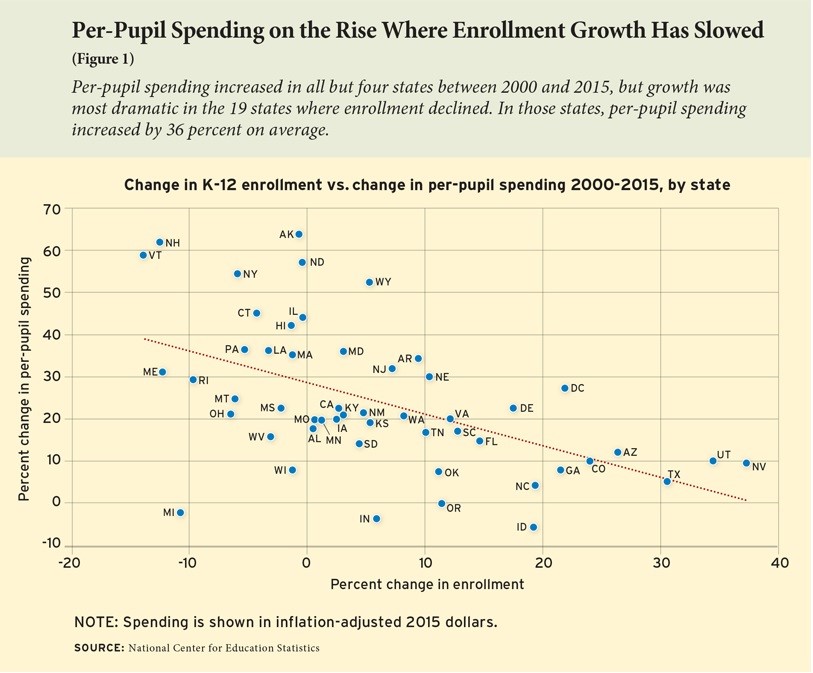Two new studies illuminate Florida K-12 funding. The first, from Mike Petrilli, president of the Thomas B. Fordham Institute and research fellow at Stanford University’s Hoover Institution, includes this chart:
So, for those of you squinting at your iPhone, the east-west axis is tracking the percent change in enrollment between 2000 and 2015, while the north-south axis is showing the constant dollar percentage increase in per pupil funding.
There obviously is a negative relationship between rapid enrollment growth and high levels of per pupil spending growth. Most of the states with very large increases saw their student population shrink. Florida looks to have seen population growth of approximately 15 percent during this period and per pupil funding growth of 18 percent.
Petrilli notes a national baby-bust, but in Florida this may simply mean a moderating of enrollment growth, already noted between older Census estimates and more recent state projections. There will be no moderation of the increase in the elderly population. A decade from now this may look like the good ole days of funding increases, so buckle up.
TaxWatch also released a study finding an “all in” per pupil number for Florida schools of $10,856. The analysis compared the traditional district school cost to the cost of two of the largest learning options the state currently provides to parents and their students – charter schools and tax-credit scholarships.
TaxWatch estimated per charter school student funding for fiscal year 2017-18 to be $7,476. The average maximum scholarship available through the Florida Tax Credit Scholarship Program, which allows children from low-income and middle-income families to attend private schools, for fiscal year 2017-18 was $6,447.
A Florida newspaper editorial board that recently editorialized that Florida “could not afford” vouchers may require some remedial math; Florida has a great deal of enrollment growth on the way and can more easily afford to choose charter and private schools than districts, although all three will remain options.




What you fail to mention is that many of the Chart and Private schools initially have lower teacher salaries. In addition, Charter Schools major accountability is either to stockholders, while Private schools are accountable to its owner. In addition Florida law does not require Private schools teachers to be college educated or certified. You don’t mention that many Charter schools are no better then Public schools and for that matter many fail miserably. Some of these schools, change their name and open under the different name. I am not denying that there are some good Charter and Private School, what I am challenging is the allegations that these schools are far better than public schools because as a whole they are not. If you compare the make up of the students in public schools to the make up of the Charted schools you will notice major differences. Public schools, have large numbers of students that are none English speakers. The Charter schools, if none English speaking students are even admitted are kept at a very low number in order to keep the test average high. Public schools can’t be that selective. In conclusion, “Choice” is a very nice word, however when searching for a school, perform your due diligence, (Analyze the school) something that most low income mother or father don’t have the time to do, because of their obligation to work and provide for the family. Keep in mind that investigative reporting articles in the Newspaper should be considered in analyzing schools. Newspapers do not have a dog in the fight. They are more impartial than people who are hired by the organization they are writing about.
Elias-
Ineffective private and charter schools certainly do exist, and there are excellent district schools as well. The official state evaluations do however go to lengths to take the various factors you mention into account when comparing sectors. What matters to families is not average sector performance but rather the available schools they have the opportunity to choose between.